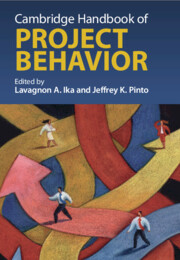Book contents
- Cambridge Handbook of Project Behavior
- Cambridge Handbook of Project Behavior
- Copyright page
- Contents
- Figures
- Tables
- Contributors
- Introduction
- Part I Guiding Principles
- Part II Deviating from Plans
- Chapter 6 Averaging Out Divergent Project Behavior
- Chapter 7 Intra- and Inter-Organizational Governance and the Behavior of Projects
- Chapter 8 Strategic Alignment, Uncertainties, and Realignment of Project Portfolios
- Chapter 9 Stakeholder Perceptions and Project Performance
- Chapter 10 Governance Shifts and Short-term Performance
- Chapter 11 Maximum Feasible Project Failure
- Chapter 12 Project Misbehavior in Infrastructure Projects
- Part III Practical Tips
- Index
- References
Chapter 12 - Project Misbehavior in Infrastructure Projects
Mega-Projects for Mega-Corruption
from Part II - Deviating from Plans
Published online by Cambridge University Press: aN Invalid Date NaN
- Cambridge Handbook of Project Behavior
- Cambridge Handbook of Project Behavior
- Copyright page
- Contents
- Figures
- Tables
- Contributors
- Introduction
- Part I Guiding Principles
- Part II Deviating from Plans
- Chapter 6 Averaging Out Divergent Project Behavior
- Chapter 7 Intra- and Inter-Organizational Governance and the Behavior of Projects
- Chapter 8 Strategic Alignment, Uncertainties, and Realignment of Project Portfolios
- Chapter 9 Stakeholder Perceptions and Project Performance
- Chapter 10 Governance Shifts and Short-term Performance
- Chapter 11 Maximum Feasible Project Failure
- Chapter 12 Project Misbehavior in Infrastructure Projects
- Part III Practical Tips
- Index
- References
Summary
This chapter employs a case study approach to explore two high-profile mega-projects, chosen for their global visibility and substantial negative impacts on Brazil’s economy and society. Initially heralded as catalysts for economic prosperity and national pride, these projects were later uncovered by police investigations to be deeply rooted in corruption. Analysis of public documents reveals that corruption was embedded from the inception of these mega-projects, with decisions driven by collusive, deliberate, and criminal intentions rather than mere ignorance. Empirical research on corruption and collusion in project management is scarce due to the clandestine nature of these activities and the challenges in data collection. Existing studies frequently rely on conceptual analyses rather than empirical evidence. The chapter introduces the concept of ‘mega-projects for mega-corruption’ to illustrate the extensive immorality involved and the role of the Malevolent Hand in facilitating corruption through strategic misrepresentation. By examining two cases involving oil refineries and soccer stadiums, the chapter underscores the necessity of robust mechanisms to combat corruption in project management. It aims to enhance practitioners’ awareness and emphasizes the need for empirical research and effective policies, such as establishing independent advisory bodies and implementing whistleblowing policies, to ensure accountability and protect public interests.
Information
- Type
- Chapter
- Information
- Cambridge Handbook of Project Behavior , pp. 181 - 198Publisher: Cambridge University PressPrint publication year: 2025
References
Accessibility standard: WCAG 2.0 A
Why this information is here
This section outlines the accessibility features of this content - including support for screen readers, full keyboard navigation and high-contrast display options. This may not be relevant for you.Accessibility Information
Content Navigation
Allows you to navigate directly to chapters, sections, or non‐text items through a linked table of contents, reducing the need for extensive scrolling.
Provides an interactive index, letting you go straight to where a term or subject appears in the text without manual searching.
Reading Order & Textual Equivalents
You will encounter all content (including footnotes, captions, etc.) in a clear, sequential flow, making it easier to follow with assistive tools like screen readers.
You get concise descriptions (for images, charts, or media clips), ensuring you do not miss crucial information when visual or audio elements are not accessible.
You get more than just short alt text: you have comprehensive text equivalents, transcripts, captions, or audio descriptions for substantial non‐text content, which is especially helpful for complex visuals or multimedia.
You can access graphs or charts in a text or tabular format, so you are not excluded if you cannot process visual displays.
Visual Accessibility
You will still understand key ideas or prompts without relying solely on colour, which is especially helpful if you have colour vision deficiencies.
You benefit from high‐contrast text, which improves legibility if you have low vision or if you are reading in less‐than‐ideal lighting conditions.
